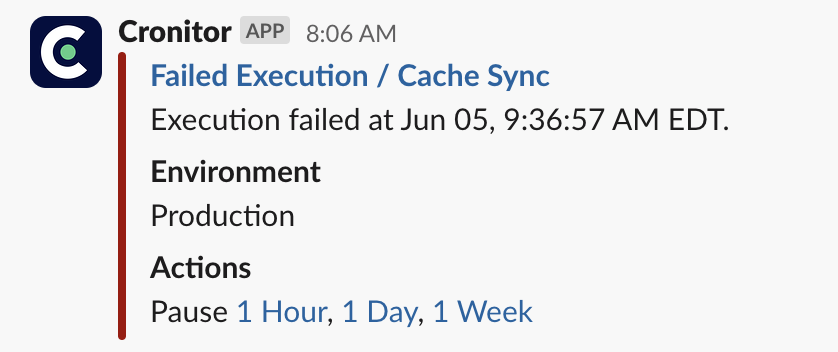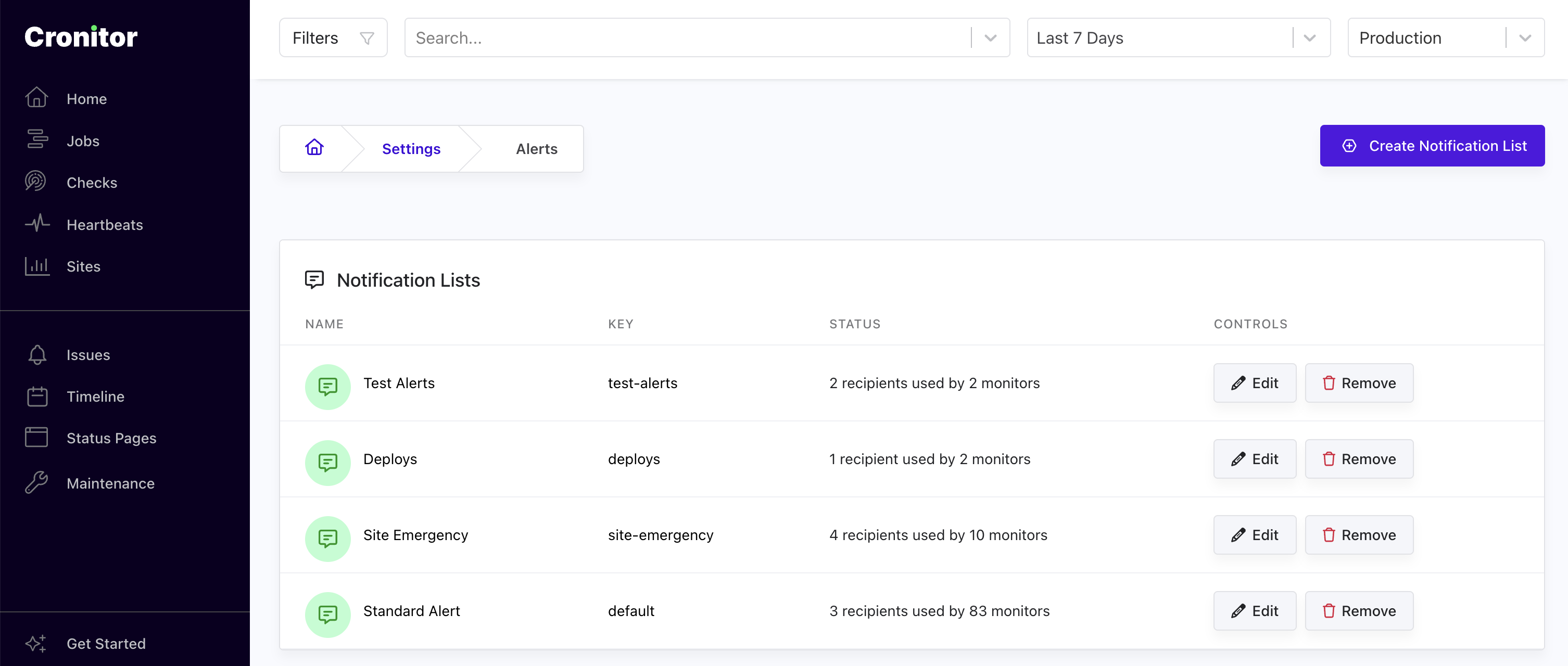Platform
Alerts & Issues
Cronitor's alert system ensures you're promptly notified when issues occur with your monitors. Alerts are what users sign up for - to be notified when their cron jobs, websites, services, or APIs fail.
When a monitor detects an issue, Cronitor automatically opens an Issue and sends Alerts to the recipients specified in your Notification Lists. Here's how these components work together:
Alerts
Alerts are the notifications Cronitor sends when a monitor fails or an assertion is violated. Recovery alerts are also sent when a monitor returns to a "healthy" state. All alerts contain:
- Issue context - Direct link to the open issue with full details
- Monitor information - Which specific monitor failed and error details
- Failure description - What went wrong and when it happened
- Recovery status - Whether the issue is ongoing or resolved
- Action links - Quick access to pause alerts, view history, or manage the monitor

Issues
Issues are Cronitor's incident management hub - they help your team coordinate response when monitors fail - issues automatically open when monitors fail and close when they recover, creating a complete incident timeline your team can reference and learn from. Each issue provides:
- Team coordination - See who's been notified and track investigation progress
- Alert visibility - View which team members received notifications and when
- Shared context - Centralized place for error details, monitor history, and resolution notes
- Status page publishing - One-click sharing to keep customers informed during outages
- Persistent tracking - Issues remain accessible for post-incident review and documentation
- Severity management - Categorize impact level and assign ownership to team members

Notification Lists
Notification Lists are reusable collections of alert recipients that you can apply to multiple monitors. They support:
- Email addresses - Send detailed alerts to any email
- SMS numbers - Text message alerts for urgent issues
- Alert integrations - Slack, PagerDuty, Teams, Discord, and more
All accounts have a default notification list. Monitors without specific alert preferences automatically use this list.
- Create new lists for different teams or alert types
- View recipient counts and which monitors use each list
- Edit or remove lists with easy-to-use controls
- See usage statistics showing how many monitors are attached

Integrations
Detailed setup instructions for popular integrations:
| Service | Description |
|---|---|
| Slack | Send alerts to channels or direct messages with rich formatting and action buttons |
| Microsoft Teams | Deliver alerts to Teams channels with embedded monitor details and quick actions |
| Discord | Post formatted alerts to Discord servers with customizable webhooks |
| Google Chat | Send alerts to Google Workspace Chat spaces using webhooks |
| Telegram | Receive alerts via Telegram bot in direct messages or group chats |
| Lark | Deliver alerts to LarkSuite channels using custom bot integrations |
| PagerDuty | Create incidents with automatic escalation, on-call routing, and resolution tracking |
| OpsGenie | Trigger OpsGenie alerts with intelligent routing and escalation policies |
| Splunk On-Call | Route alerts through Splunk On-Call with timeline integration and team coordination |
| Webhooks | Send custom HTTP requests to any endpoint with flexible payload formatting |
Configuring Alerts
1. Create integrations
Navigate to Settings > Integrations to connect your preferred services.
Once configured, these integrations can be added to any Notification List for reuse across multiple monitors.
Popular integration types include:
- Chat platforms like Slack, Microsoft Teams, and Discord
- Incident management tools like PagerDuty, OpsGenie, and Splunk
- Communication services like Telegram and email
- Custom webhooks for your own systems

2. Create Notification Lists
Go to Settings > Alerts to manage your notification lists:
- Click Create Notification List
- Add a name and unique key
- Select recipients: emails, phone numbers, and integrations
- Choose which environments the list should be active in

3. Attach Lists to Monitors
When creating or editing a monitor, specify which notification lists should receive alerts. You can:
- Select existing notification lists
- Add individual email addresses or phone numbers
- Use different lists for different types of alerts

Sending Test Alerts
To verify your alert setup is working correctly, create a test heartbeat monitor and use its telemetry URL to trigger alerts:
1. Create a Test Monitor
Create a new heartbeat monitor and configure it with the notification list you want to test.
2. Send a Normal Ping
Copy the telemetry URL from your new monitor and paste it into your browser. Hit enter to send a normal "healthy" ping. This initializes the monitor and confirms it's working.
3. Trigger a Failure Alert
Add ?state=fail to the end of the telemetry URL and hit enter. For example:
https://cronitor.io/p/API_KEY/test-alert?state=fail
This simulates a monitor failure and triggers an alert to all recipients in your notification lists. Wait for the alert to arrive via your configured channels.
4. Send a Recovery Alert
Remove the ?state=fail parameter from the URL and hit enter again. This sends a recovery ping, which will trigger a recovery alert letting your team know the "issue" has been resolved.
API Resources
Manage alerts programmatically using our APIs:
- Issues API - Create, update, and retrieve issues
- Template API - Manage notification lists
- Monitor API - Configure alert preferences for monitors